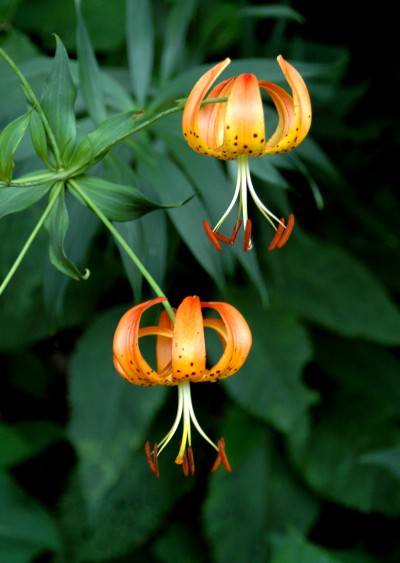Turk's Cap Lily Credit Vicki Dameron.jpg
 Native to eastern and central North America, Turk’s cap lily begins its season in June and can be found through August. Photograph by Vicki Dameron
Native to eastern and central North America, Turk’s cap lily begins its season in June and can be found through August. Photograph by Vicki Dameron After the gray and white landscape painted by winter, spring brings a great sense of renewal to the Blue Ridge Parkway. The diverse blooms, ranging from delicate to bold, that herald the season’s arrival are one of many reasons to hit the road and explore the trails for wildflower sightings amid the vibrant landscape.
There are more than 1,600 vascular plants that call the park unit home, and about 80 percent are wildflowers, according to the National Park Service. The abundant rainfall, moderate climate, and diverse habitats, from fields and forests to ridges and coves, contribute to the wondrous variety of Appalachian flora. Bloom times vary greatly depending on elevation and direction of the slopes. If you miss a flower bloom at a lower elevation, you can still catch the show at a higher vista. “As you go up in elevation, you go back in time,” explains Chris Ulrey, plant ecologist with the Blue Ridge Parkway. “Spring starts in the valleys and finishes on the peaks. A flower can be blooming on a peak a month behind the lower elevations.”
To plan your wildflower excursions, look to the trees for signs of the best opportunities. When leaves begin to bud, it’s a good time to head out. By the time the leaves begin to fill in the canopy, the flowers are fading, Ulrey explains. The blooms to catch in May and June include pink shell and flame azalea, bluets, columbine, fire pink, phlox, mountain laurel, wild geranium, dogwoods, Virginia spiderwort, Turk’s cap lily, and many more. As summer takes hold, look for black-eyed Susan, tall coneflower, Oswego tea, bellflower, and pokeberry, among others.
When you set out to see the colors that dot the trails, keep a few tips in mind:
- Step lightly. One of the greatest dangers to plants is being trampled by visitors. It’s best to stick to the marked trails, avoid shortcuts, and make sure dogs are kept on a leash.
- Let it grow. As tempting as it might be to pluck a bloom or even transplant a sprout, resist the urge: it’s illegal. Instead, snap a photo and take it to your local garden center to find a propagated specimen for your landscape. Plant poaching is an issue along the Parkway, so don’t purchase plants that appear to have been harvested from the forest. It encourages continued damage to the natural environment and there is no guarantee the plant will transplant well into your yard. For example, orchids are particularly sensitive to shifts in their environment.
- Find a Flower. The Parkway wants you to see the show. During the spring and summer, call (828) 298-0398 for the latest wildflower report from points along the Parkway. Or check out the bloom calendar.
Note: This article originally appeared in the Spring 2015 edition of Carolina Mountain Life magazine.







